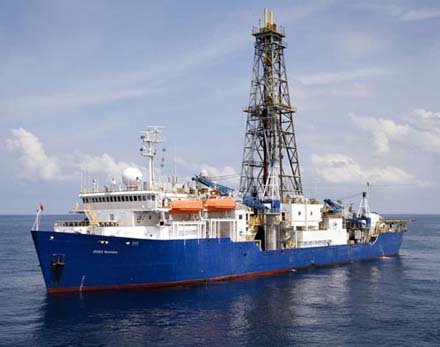Several weeks before Expedition 335 began, a student named Devon read about our upcoming expedition in an online article while doing research for a current events project for his science class. As he explained in an email to our co-chief, Benoit Ildefonse…
“While I was scanning the Internet the article on this drilling expedition caught my eye. I read it through and as I read questions popped into my head. When I finished reading I still have a few unanswered questions. I was wondering if you would answer them for me. If you would, I would be very grateful.”
We thought we’d share with you Devon’s questions about the scientific ocean drilling process, along with Benoit’s answers.
Here are the questions Devon asked about how we drill…
“How will the drilling device be able to take the samples of rock from the crust and hold them all the way up to the boat? How will the drilling device be lowered into and retrieved out of the water? How will the drilling device and the boat contact each other to signal that it has reached the ocean floor and that it should start drilling?”
And here’s how our co-chief replied…
These questions are based on the idea that we send a drilling device down to the seafloor that is disconnected from the ship, which isn’t quite correct.
Drilling is actually done from the ship, which has a derrick that is able to deploy, down to the seafloor and into the rocks below, a drilling pipe that is progressively assembled using the derrick. (The derrick is that tall metal tower you see in the photo of the ship above). Once the drilling bit is in contact with the rocks, the drilling pipe is rotated from the ship, and we begin to drill.
This process is somewhat similar to what you do when you drill a hole in your wall with your favorite drill,…
…except that our drill (shown in the photo below) is significantly bigger, a bit more complicated as we are on a ship (which must be kept in place using several thrusters, in a process that’s called dynamic positioning), and we want to core, as well as drill.
When we say we want to core, that means that when we drill, we want to recover rock cores that are about 6 centimeters in diameter. Every ten meters, we stop drilling, open the pipe in the derrick, and send an instrument called a core catcher (shown in the photo below) with a winch and a cable to recover the core at the other end of the pipe.
To learn more about how drilling works on our ship the JOIDES Resolution, you can take a look at the video, “JR Drilling Operations 24/7”. You might also want to read about the Chikyu, which is another ship used by the Integrated Ocean Drilling Program to do what is called “riser drilling.”
[Photos by John Beck and Bill Crawford.]



